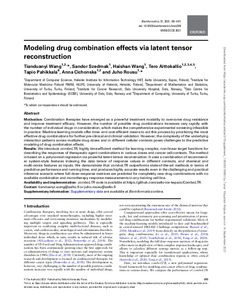Modeling drug combination effects via latent tensor reconstruction
Wang Tianduanyi; Szedmak Sandor; Wang Haishan; Aittokallio Tero; Pahikkala Tapio; Cichonska Anna; Rousu Juho
https://urn.fi/URN:NBN:fi-fe2021093048185
Tiivistelmä
AB Combination therapies have emerged as a powerful treatment modality to overcome drug resistance and improve treatment efficacy. However, the number of possible drug combinations increases very rapidly with the number of individual drugs in consideration, which makes the comprehensive experimental screening infeasible in practice. Machine-learning models offer time- and cost-efficient means to aid this process by prioritizing the most effective drug combinations for further pre-clinical and clinical validation. However, the complexity of the underlying interaction patterns across multiple drug doses and in different cellular contexts poses challenges to the predictive modeling of drug combination effects.We introduce comboLTR, highly time-efficient method for learning complex, non-linear target functions for describing the responses of therapeutic agent combinations in various doses and cancer cell-contexts. The method is based on a polynomial regression via powerful latent tensor reconstruction. It uses a combination of recommender system-style features indexing the data tensor of response values in different contexts, and chemical and multi-omics features as inputs. We demonstrate that comboLTR outperforms state-of-the-art methods in terms of predictive performance and running time, and produces highly accurate results even in the challenging and practical inference scenario where full dose–response matrices are predicted for completely new drug combinations with no available combination and monotherapy response measurements in any training cell line
Kokoelmat
- Rinnakkaistallenteet [27094]
